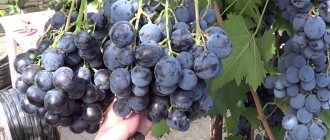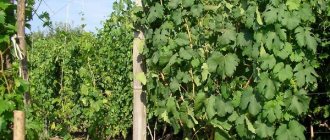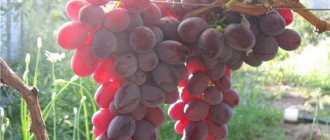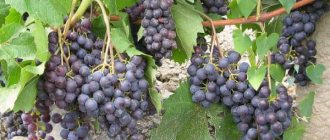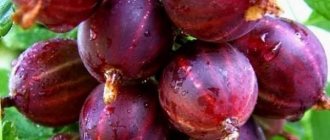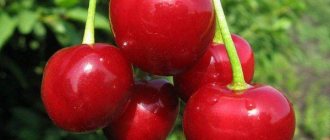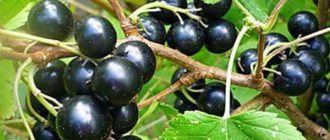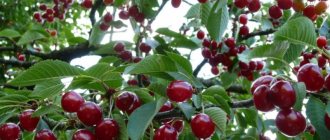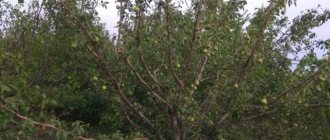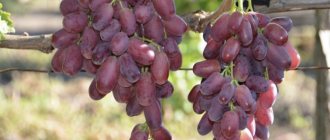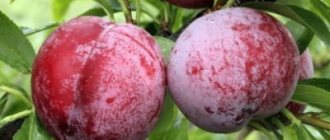Description of the variety
Beauty is an early ripening table grape variety. The growing season is only 110-115 days. The bush is medium-sized, the vine ripens well. It is possible to grow in the northern regions, but only with covering the plant for the winter.
Immunity is at an average level. Beauty needs periodic treatment from oidium and mildew, in general, like any grape variety known to us.
The clusters are medium, their weight reaches about 0.5-0.8 kg. Conical shape.
The berries are medium-sized, oblong. The tip of the fruit is pointed. The color of the shell is heterogeneous. In certain areas it takes on a dark purple hue, in others it turns pink. It is this coloring that makes the variety a real “beauty”. The average weight of a mature fruit is 7-8 grams.
The berry has a pleasant taste. The harmonious content of sugar and acid is maintained. Sugar content reaches 15%, acidity 7 g/dm3.
The skin is thin and edible. When used it is not felt at all.
The berry has good shelf life. The shell protects it during transportation. But storing the bunches on the bush is not recommended. If the harvest is not harvested on time, then the fruits begin to soften and the skin bursts, even if there was no strong humidity.
The flowers of the plant are bisexual. But if it is grafted onto another variety, then pollination occurs a little worse than in the main form.
Claimed frost resistance is -23 degrees Celsius. But this is not exact data, since Pavlovsky is still an amateur. And almost all winegrowers who grow Beauty cover it for the winter.
To obtain a good harvest, the bush must be normalized. The standard is no more than 40 buds per plant.
Beauty can also boast of her immunity. When performing standard preventive spraying, the likelihood of encountering some kind of disease is minimal.
The variety is not resistant to wasp attack. Therefore, it needs high-quality protection. Experienced gardeners use special fine mesh covers that are placed on each bunch. But for an amateur gardener, this method of care can cost a pretty penny, so most often beginners look for nests or place special distracting baits.
Also, additional crops can be grown on stepchildren. But for this you need one requirement - a warm autumn. Only in this case will the additional harvest have time to ripen.
Appearance
The desire to grow the Krasotka variety on your own plot arises at the first acquaintance from a photo, and the stories of friends and reviews on the forum further stir up interest. And those who decide to grow this variety will not be disappointed.
The amazing beauty of the clusters gives the plant its high aesthetics. They have a cylindrical or cone-cylindrical shape, and the color of the berries surprises and delights. The grape is large, oval with a slight slope towards the tip .
Among the beautiful varieties one can note Romeo, Taifi and Chocolate.
The color ranges from soft pink to coral, and the part of the berry where we observe the ripening has a blue-violet color in different tones or chocolate if the shade of the berry is coral. It seems as if each berry was painted separately, dipping each tip into a special paint.
The size of the brush is average, about 400 grams , but with proper agricultural technology, the quality of the harvest improves and the bunches gain weight up to 600 grams, and the grapes 12-14 grams, the color intensity increases. The skin of the berry is tender.
Advantages
The variety has a lot of tricks up its sleeve that make it a worthy competitor in the world market. The main advantages of Beauty look like this:
- High resistance to sunlight. Many varieties receive so-called “burns” due to which they lose their taste. The beauty feels good under the rays of the scorching sun.
- Good immunity protects the plant from oidium and gray rot.
- Average resistance to mildew.
- Stable yield.
- High frost resistance up to -23 C.
- Early fruit ripening.
- High demand in the market, attractive appearance.
History of selection
It should be noted that interest in grapes as a garden crop has grown significantly in recent years.
This happens not only due to the taste of the fruit and a wide selection of processing methods, but also due to the variety of types and varieties. Passion gradually develops into skill, becomes a part of life, and a desire appears to create your own variety and choose a name for it.
The Krasotka variety was created by amateur breeder E.G. Pavlovsky . For his work, he used the Victoria variety and a mixture of pollen from European-Amur forms.
The same breeder owns Super Extra, Monarch and Baikonur.
Landing
This is one of the easiest varieties to care for. However, it is still better to follow a number of rules that will ensure 100% survival of the young seedling:
- For planting, choose a well-lit area.
- The acidity level should not be high.
- During planting, ensure good soil drainage.
- Groundwater must lie at a depth of more than 1.5 m.
There are no special requirements for the type of soil; Beauty grows in any soil. But still, sandy or chernozem soils are preferable.
Before planting crops, carefully prepare the area:
- First of all, we dig up the soil. If it is sour, then it needs to be quenched. Also, good feeding will not hurt. But keep in mind the fact that lime extinguishes all the beneficial properties of the fertilizer. Therefore, experts recommend carrying out preparatory work long before the planned planting.
- We prepare drainage from stones. If the soil is sandy loam, then drainage is not needed, since this type of soil allows water and air to pass through perfectly.
The ideal time to plant the Beauty variety is spring. Plant the plant until the leaves bloom and active growth begins.
The grapes are planted in a hole 50-60 centimeters deep. Immediately after planting, the crop is watered and a layer of mulch is made.
Grape care
This is an undemanding variety, but still, good care will only be beneficial. Like any other grape, Beauty loves watering, fertilizer and protection from parasites and diseases.
Watering
When watering, you need to focus on weather conditions. If it is very hot outside, then water the grapes 2-3 times a week. If it rains, it is better to refuse watering. The variety cannot be flooded, as Beauty has a tendency to crack.
Watering is stopped 10-12 days before harvest.
Rationing
Rationing has a beneficial effect on yield:
- In the first year of life, in the month of August, the top of the bush is cut off. After the leaves fall, the vine is pruned, leaving only 3-4 buds on it.
- In the second year, the 4 strongest vines are chosen. 5 buds are left on them. The rest, weak and dry vines, are removed.
- In the third year of life, in the fall, one, the strongest shoot is left on the vine. Trim it to 5 buds.
Feeding
In the first year of planting, there is no need to feed the crop, since the soil has already been nourished with useful elements, which are quite enough for the normal growth of grapes.
From the second year of life, grapes begin to be fertilized. In spring it is nitrogen fertilizers. They will promote green growth and root system development. During flowering, ripening of berries and before hibernation, the plant needs phosphorus fertilizers.
Protecting grapes in winter
Despite the declared high frost resistance, experienced gardeners do not take risks and still cover the grapes when frost sets in.
To protect the roots, after autumn rationing, a small hole (about 10 cm) is dug out, which is filled with sawdust. Afterwards, the sawdust is covered with soil.
Then bars or boards are placed under the vines and the folded grapes are placed on them. All this is well wrapped, and with the onset of winter, it is advisable to cover the crop with snow to protect it from severe frosts.
Reviews
GF Krasotka has very good pulp and good taste.
Resistance to mildew is also quite high, and it is imperative to cover the bushes of this GF. The vine ripening is good, ripens in our conditions on August 10–15. The only thing I don’t like is that in our conditions, in the grafted culture, there is one unpleasant problem - shedding of the ovary. Every year, regardless of weather conditions, flowering and other factors. Sometimes, despite such shedding, it pollinates very well, sometimes (as, for example, last year) there were no bunches at all, just scraps. Any lotions in the form of spraying with boron-containing preparations do not help. The picture is the same on all bushes in three areas. Therefore, I personally consider this gf unstable. Krasokhina https://forum.vinograd.info/showthread.php?t=2414
But on my BEAUTY a light shade of candy appeared.
And the berry is tasty, fleshy, with a crunchy effect... Let it hang a little more in the bags - the wasps really liked it... Alexander https://forum.vinograd.info/showthread.php?t=2414&page=11
GF Beauty got its name for a reason: the berries and clusters are attractive!
And the taste is also excellent: the sweet, juicy, firm pulp with a hint of vanilla will not leave anyone indifferent. The advantage is that the form is stated to have disease resistance of 3.5 points, but in our problem area with high constant humidity and poor ventilation, I didn’t even see signs of disease, of course, this was with standard preventive treatment of the entire vineyard. I receive a lot of good feedback from the northern regions on this form: the vine ripens early and along its entire length, the berries pick up sugar well at low temperatures in summer. Bunches of GF Krasotka within 500–800 gr. or more, berries weighing 7–12 grams. in our vineyard. Fursa Irina Ivanovna https://vinforum.ru/index.php?topic=29.0
For those who raise Beauty, I recommend getting a piglet.
The piglets really like the cracked and unripe Beauty. You yourself are unlikely to feast on Beauty, but the grunty ones will eat her for her sweet soul. Plant something better for yourself. At least those varieties that do not crack. I don’t recommend messing with unsustainable grape varieties, especially those whose berries turn into complete trash before ripening. Alex-63 https://vinforum.ru/index.php?topic=29.40
I read a lot of different things about Beauty: some praise, some scold, primarily for the crackling of the berries.
After two years of observing her, I have only positive emotions. Resistant to diseases, withstood the spring frosts of 2014 well, strong growth, good ripening of the vines, beautiful clusters, large, tasty berries, cod, thank God, not yet. Yuri Semyonov https://lozavrn.ru/index.php?topic=92.0
Beauty has a very rich, harmonious taste in which the floral aroma is very well felt, in the taste there are slightly tones of cherry (reminiscent of the Valery Chalov variety) and vanilla.
I didn't smell any nutmeg, although perhaps the floral aroma simply overwhelmed the light nutmeg aroma. The flesh of the Beauty is dense, the skin is tender. I would not recommend keeping Beauty on the bush for a long time because of the wasps. Sergey Dandyk https://www.vinograd7.ru/forum/viewtopic.php?f=59&t=162&sid=ac4a2def85018b3b23797acb64a96256&start=90
Diseases
The beauty has relatively good immunity. However, it is not protected from diseases such as mildew, gray mold, anthracnose and oidium.
Mildew
When infected with mildew fungus, the surface of the leaves becomes covered with reddish spots, and their back side becomes covered with a white coating. Initially, the fungus settles on leaves and young shoots. When the pathogen develops, it begins to move to the fruits. As a result of the infestations, the affected areas dry out and eventually die.
The fungus actively spreads at high air humidity. The ideal environment is 85% humidity.
To treat crops from this disease, special fungicides are used, including Ridomil Gold.
Gray rot
This disease is very easily classified as the plant is covered with gray spots with a coating. The plaque contains spores that spread in the wind through physical contact (touching with fingers, etc.). The ideal temperature for the rapid spread of the pathogen is 22-28 C. From this we can conclude that gray mold operates mainly in the middle of summer.
After a plant is infected by this fungus, the infested areas begin to dry out and die. The pathogen completely infects the crop, including berries. When the latter are damaged, they become covered with a gray coating and begin to rot.
This pest is controlled with fungicides. It is advisable to carry out 3 treatments per growing season. The first - before flowering (May), the second - before the formation of ovaries (June), the third - before the berries ripen (July).
You shouldn’t give up folk remedies either. In this case, treatment with a baking soda solution has proven effective.
Oidium
Aka powdery mildew. A disease that poses a serious threat to crops. Characteristic signs of oidium infestation are the appearance of a white coating on the leaves and shoots. Peak infections occur in the spring.
If the pathogen is not fought, then it progresses. The white coating takes on a gray tint and the affected areas, including the berries, begin to die.
We recommend reading: “Furor grapes - an attractive giant”
Ideal conditions for the spread of the disease are high ambient humidity.
Sulfur-based fungicides are used as preventive and therapeutic agents.
A good alternative to industrial chemistry can be the folk method - a solution of wood ash with laundry soap.
Anthracnose
Also one of the most common fungi that infects the Krasotka variety. The first symptoms are “rusty” spots on the leaves of the crop. Gradually the disease spreads to the entire plant. The affected areas soon die.
The ideal temperature for the spread of the disease is 25 C. Just like any fungus, anthracnose loves high humidity.
To prevent the crop from encountering this disease, in the spring, even before the buds open, the grapes are treated with Bordeaux solution. To do this, 700 g of the substance is diluted in a bucket of water.
